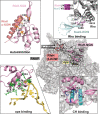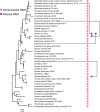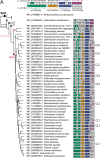Origins and Molecular Evolution of the NusG Paralog RfaH
- PMID: 33109766
- PMCID: PMC7593976
- DOI: 10.1128/mBio.02717-20
Origins and Molecular Evolution of the NusG Paralog RfaH
Abstract
The only universally conserved family of transcription factors comprises housekeeping regulators and their specialized paralogs, represented by well-studied NusG and RfaH. Despite their ubiquity, little information is available on the evolutionary origins, functions, and gene targets of the NusG family members. We built a hidden Markov model profile of RfaH and identified its homologs in sequenced genomes. While NusG is widespread among bacterial phyla and coresides with genes encoding RNA polymerase and ribosome in all except extremely reduced genomes, RfaH is mostly limited to Proteobacteria and lacks common gene neighbors. RfaH activates only a few xenogeneic operons that are otherwise silenced by NusG and Rho. Phylogenetic reconstructions reveal extensive duplications and horizontal transfer of rfaH genes, including those borne by plasmids, and the molecular evolution pathway of RfaH, from "early" exclusion of the Rho terminator and tightened RNA polymerase binding to "late" interactions with the ops DNA element and autoinhibition, which together define the RfaH regulon. Remarkably, NusG is not only ubiquitous in Bacteria but also common in plants, where it likely modulates the transcription of plastid genes.IMPORTANCE In all domains of life, NusG-like proteins make contacts similar to those of RNA polymerase and promote pause-free transcription yet may play different roles, defined by their divergent interactions with nucleic acids and accessory proteins, in the same cell. This duality is illustrated by Escherichia coli NusG and RfaH, which silence and activate xenogenes, respectively. We combined sequence analysis and recent functional and structural insights to envision the evolutionary transformation of NusG, a core regulator that we show is present in all cells using bacterial RNA polymerase, into a virulence factor, RfaH. Our results suggest a stepwise conversion of a NusG duplicate copy into a sequence-specific regulator which excludes NusG from its targets but does not compromise the regulation of housekeeping genes. We find that gene duplication and lateral transfer give rise to a surprising diversity within the only ubiquitous family of transcription factors.
Keywords: NusG; RfaH; Spt5; antitermination; transcription.
Copyright © 2020 Wang et al.
Figures








Similar articles
-
Flipping states: a few key residues decide the winning conformation of the only universally conserved transcription factor.Nucleic Acids Res. 2017 Sep 6;45(15):8835-8843. doi: 10.1093/nar/gkx523. Nucleic Acids Res. 2017. PMID: 28605514 Free PMC article.
-
Functional specialization of transcription elongation factors.EMBO J. 2009 Jan 21;28(2):112-22. doi: 10.1038/emboj.2008.268. Epub 2008 Dec 18. EMBO J. 2009. PMID: 19096362 Free PMC article.
-
RfaH Counter-Silences Inhibition of Transcript Elongation by H-NS-StpA Nucleoprotein Filaments in Pathogenic Escherichia coli.mBio. 2022 Dec 20;13(6):e0266222. doi: 10.1128/mbio.02662-22. Epub 2022 Oct 20. mBio. 2022. PMID: 36264101 Free PMC article.
-
NusG-Spt5 Transcription Factors: Universal, Dynamic Modulators of Gene Expression.J Mol Biol. 2025 Jan 1;437(1):168814. doi: 10.1016/j.jmb.2024.168814. Epub 2024 Oct 5. J Mol Biol. 2025. PMID: 39374889 Free PMC article. Review.
-
Tuning the sequence specificity of a transcription terminator.Curr Genet. 2019 Jun;65(3):729-733. doi: 10.1007/s00294-019-00939-1. Epub 2019 Feb 9. Curr Genet. 2019. PMID: 30739200 Free PMC article. Review.
Cited by
-
Concerted transformation of a hyper-paused transcription complex and its reinforcing protein.Nat Commun. 2024 Apr 8;15(1):3040. doi: 10.1038/s41467-024-47368-4. Nat Commun. 2024. PMID: 38589445 Free PMC article.
-
Frustration In Physiology And Molecular Medicine.ArXiv [Preprint]. 2025 Feb 6:arXiv:2502.03851v1. ArXiv. 2025. Update in: Mol Aspects Med. 2025 Jun;103:101362. doi: 10.1016/j.mam.2025.101362. PMID: 39975445 Free PMC article. Updated. Preprint.
-
Comprehensive analysis of Enterobacteriaceae IncX plasmids reveals robust conjugation regulators PrfaH, H-NS, and conjugation-fitness tradeoff.Commun Biol. 2025 Mar 4;8(1):363. doi: 10.1038/s42003-025-07782-w. Commun Biol. 2025. PMID: 40038536 Free PMC article.
-
Metamorphic proteins under a computational microscope: Lessons from a fold-switching RfaH protein.Comput Struct Biotechnol J. 2022 Oct 21;20:5824-5837. doi: 10.1016/j.csbj.2022.10.024. eCollection 2022. Comput Struct Biotechnol J. 2022. PMID: 36382197 Free PMC article. Review.
-
Many dissimilar NusG protein domains switch between α-helix and β-sheet folds.Nat Commun. 2022 Jul 1;13(1):3802. doi: 10.1038/s41467-022-31532-9. Nat Commun. 2022. PMID: 35778397 Free PMC article.
References
Publication types
MeSH terms
Substances
Grants and funding
LinkOut - more resources
Full Text Sources
Molecular Biology Databases
